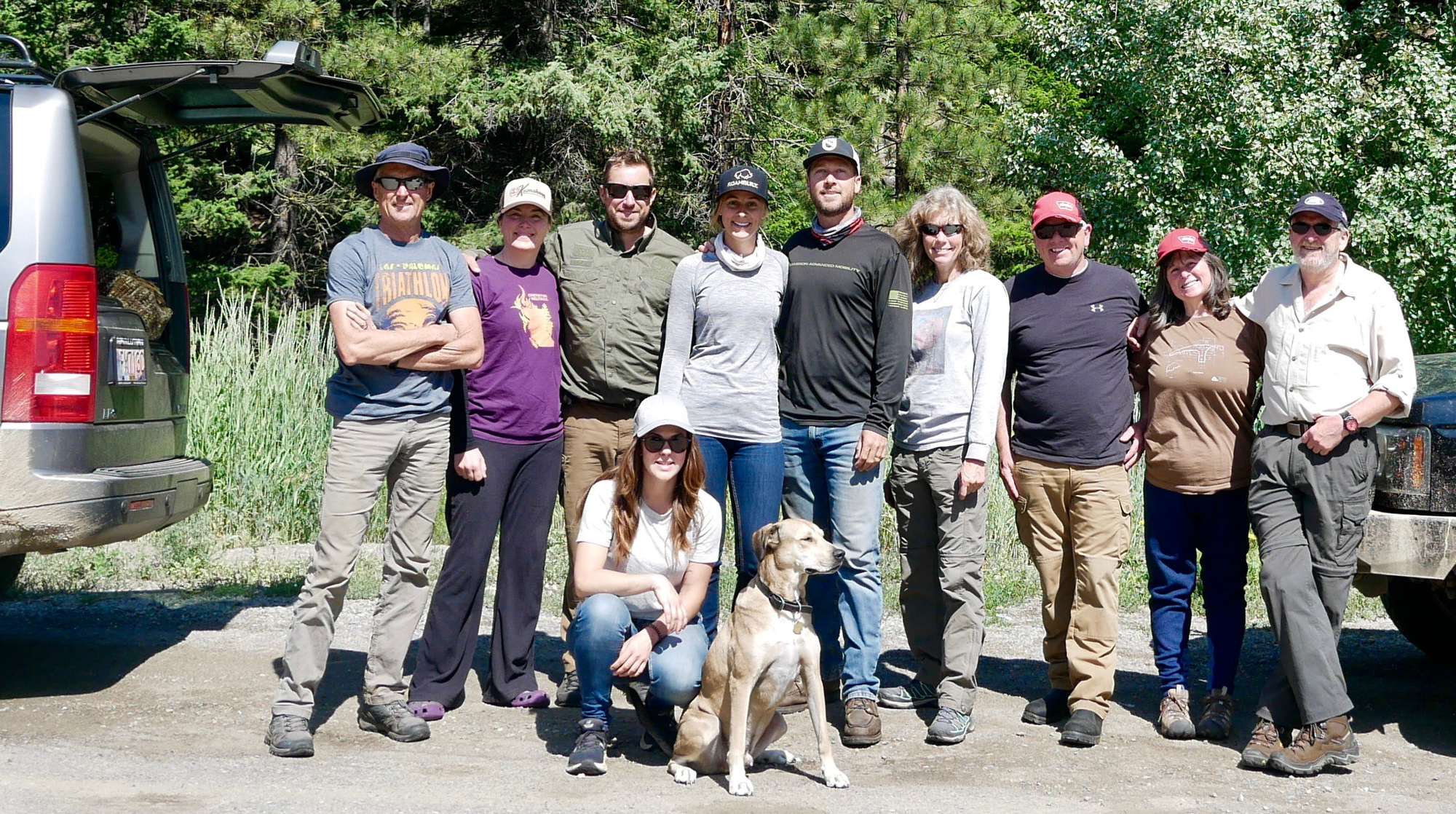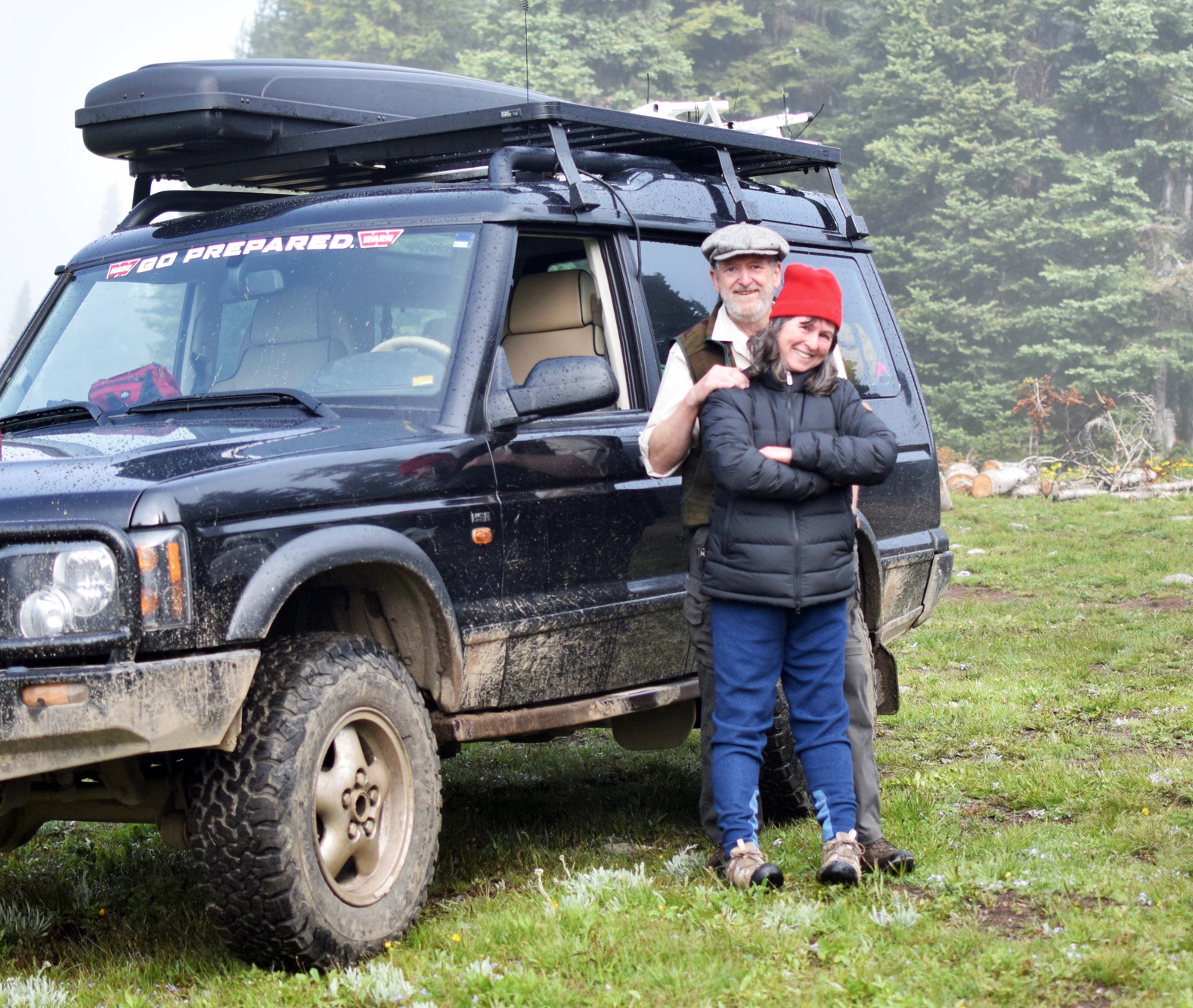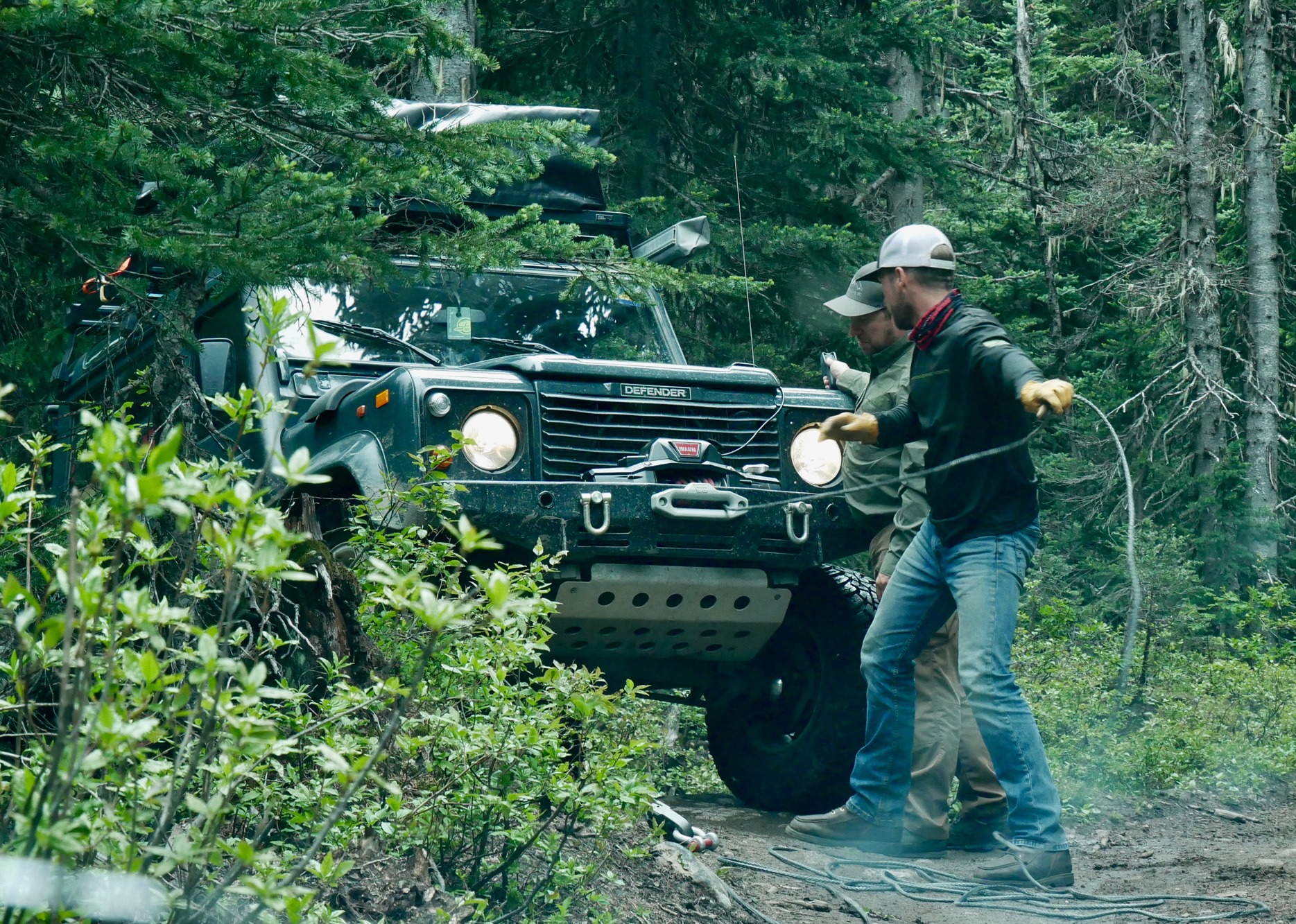What do experienced overlanders do when a disabled truck needs to be recovered on the trail? Some of North America’s best off-highway driving instructors and vehicle recovery experts showed us their skills when they recovered a disabled truck from the historic Whipsaw Trail in July 2019. My husband, Steve, and I have driven Whipsaw four times, and this will go down as our most memorable trip. After attending the Northwest Overland Rally in Plain, Washington, and the BC Overland Rally in Whistler, British Columbia, we were among a small group of overlanders who headed to Whipsaw for a three-day trip
The famed trail is in southern British Columbia, Canada, near the towns of Princeton and Coalmont. It was designated a BFGoodrich Outstanding Trail in 2007. The 70-kilometer (43-mile) winding trail has many technical obstacles with some easy parts, placid lakes and ponds, and in summer, alpine fields bejeweled with colorful wildflowers. The views of the surrounding mountains from the alpine fields at about 2,000 meters (6,000 feet) evoke awe that puts into perspective our tiny place in the world, bringing with it a sense of joy, especially at sunset. But there are also hordes of bloodthirsty insects that even a liberal application of DEET sometimes fails to deter.

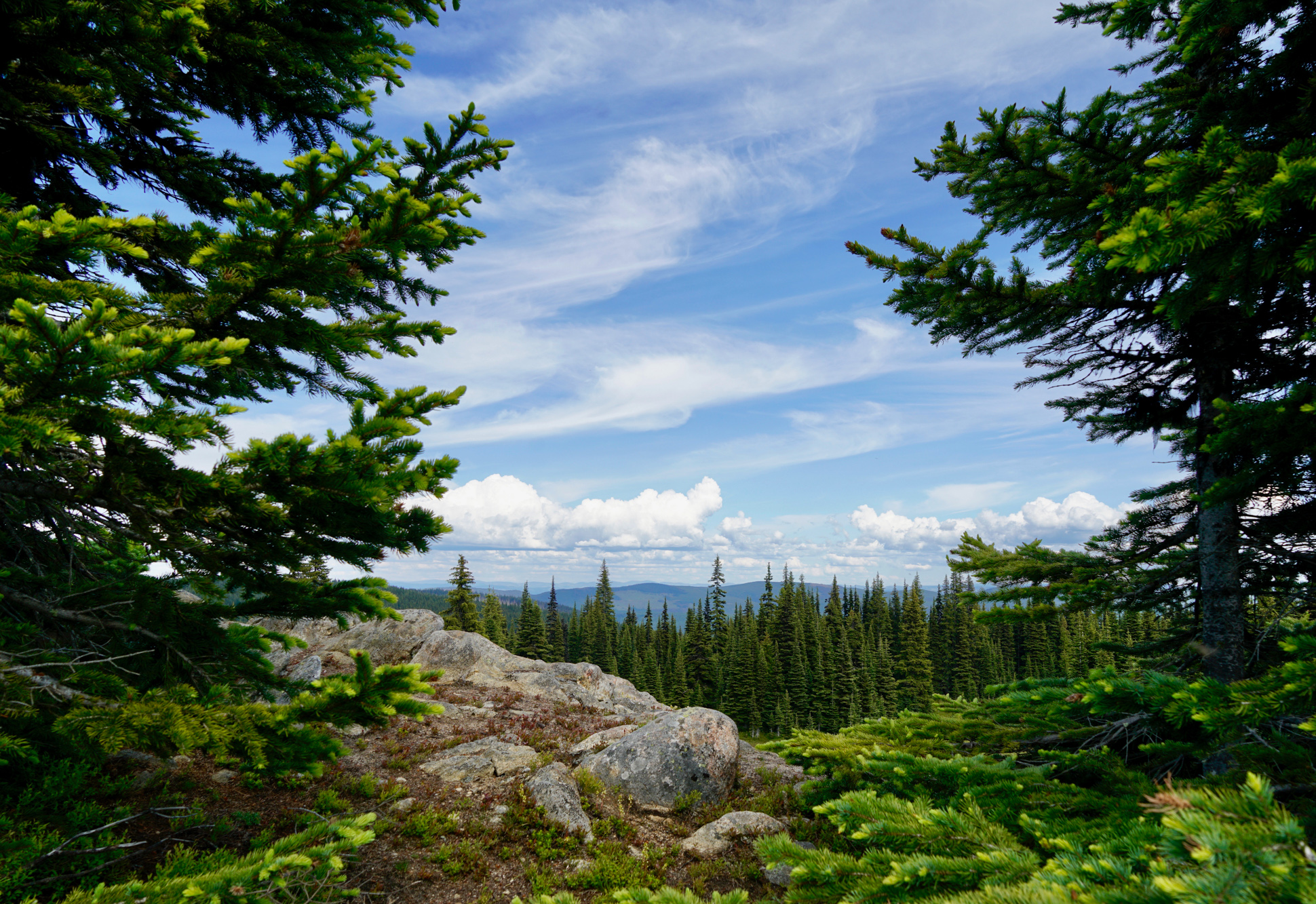
The Whipsaw Trail dates back to the days the Sto:lo First Nations traversed the area, about 8,000 years ago. Beginning in 1849, the Hudson’s Bay Company used the Sto:lo trails, carrying furs and other goods, as did men during the short-lived Similkameen Gold Rush in 1860. In the 1900s, a mining road was built along the trail to transport ore from Lodestone Lake to settlements nearby. The trail name may be derived from the work of early gold miners in the area. Helen B. Akrigg and G.P.V. Akrigg in their book, 1001 British Columbia Place Names, noted, “Early gold-hunters, needing lumber out of which to build sluice-boxes and flumes, whipsawed their lumber in sawpits close to this stream (Whipsaw Creek).”
On the 2019 Canada Day (01 July) long weekend, Steve and I traversed Whipsaw with Overlanding BC instructors Chris Walker and Paul Cooper, former Camel Trophy driver (Guyana 1992) Jim West, and the 7P Overland group, Tim and Kelsey Hüber and Kim Casares. Overlanding BC and 7P teach across North America. If they can’t get a truck unstuck, probably no one else can. Also along with us were Rebelle Rally driver Penny Dale and her canine companion, Wyatt.
Chris Walker, who drives Whipsaw often, warns, “It’s a fun trail, not the hardest in the world, but never underestimate it. It definitely has enough remoteness and plenty of rough terrain to be a dangerous place if you aren’t paying attention.”
On our first day, before heading on to the Whipsaw Trail, we took a side trip to the abandoned coal-mining site of Blakeburn.

Blakeburn, in existence from 1922 to 1940, was a company-owned coal-mining town on a 12-square-mile site, home to less than 1,000 residents. It’s perched on the southern slope of Lodestone Mountain across from the coal-mining hamlet of Coalmont, northwest of Princeton, and got its name from businessmen Blake Wilson and Pat Burns.
In August 1930, disaster befell the mine. Forty-six men working underground were hit by two explosions, with only one survivor. The mine continued operating until 1940 when it was closed because it became unprofitable.
Nothing of the vibrant town remains except beautiful lines of coal in the mountainside —and perhaps the spirits of lost miners.
On the morning of the second day, we were halfway through Whipsaw, heading down the hill to the popular Wells Lake, when Jim’s truck stalled. Recalled Jim, “I was going down the hill, braking to ease into it, when my Discovery stalled. I went to start it, and it sounded wrong. I coaxed my truck to the bottom of the hill, then got out. Initially, we thought it was a fuel pump problem, but the fuel pump was working. We took a look at the injection pump and pulled it open to look at the pulley. The pulley was not spinning, so we were pretty sure it was a broken timing belt.”
With no possible quick fix on the trail, Jim’s truck would have to be towed out.
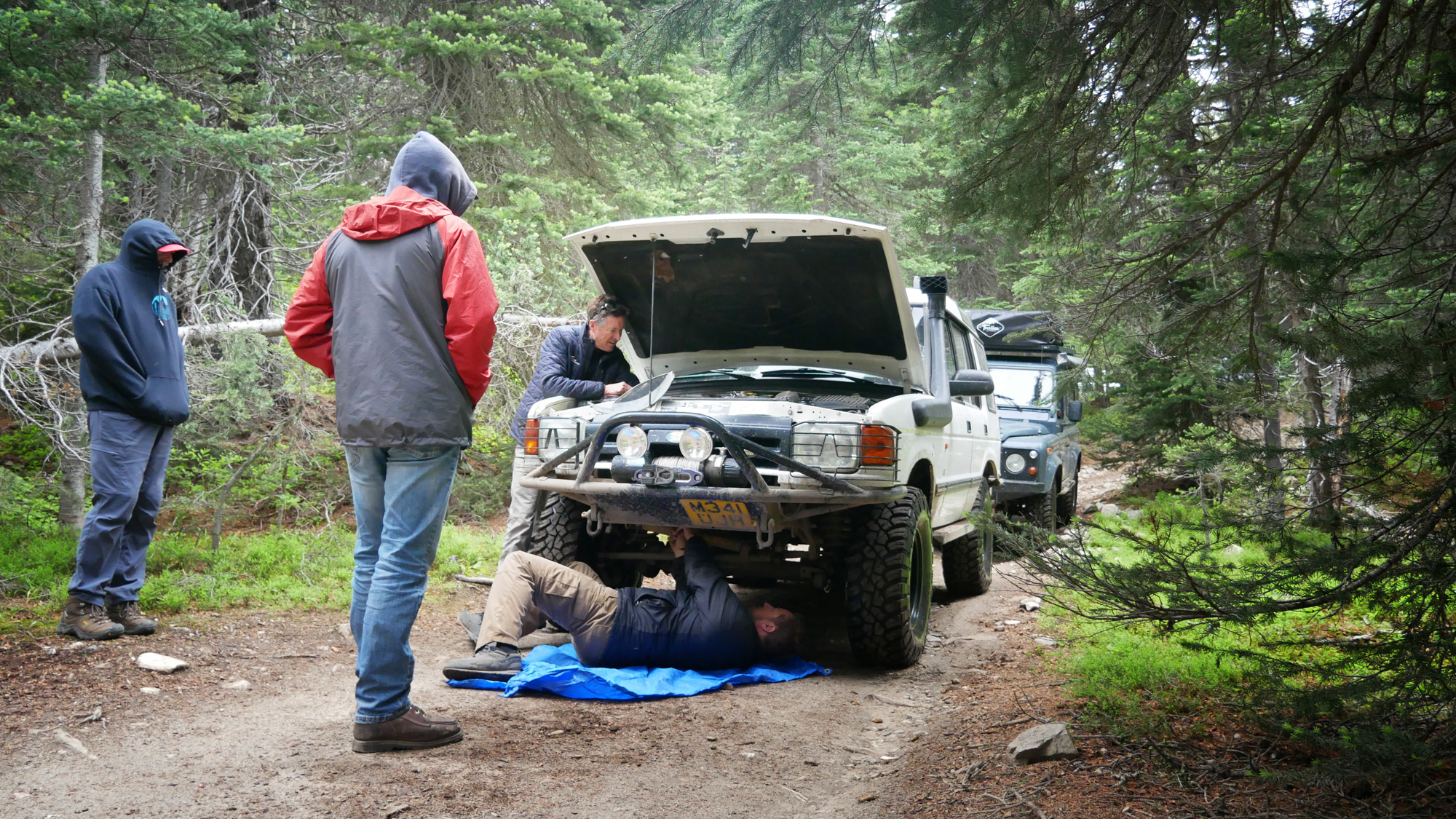
Here’s how the recovery unfolded
The first question was whether to go back or to continue forward. The consensus was that both ways would be equally difficult. We continued forward.
“Even I did not realize how difficult it might be,” reflected Paul Cooper, driver of the Toyota 4Runner.
The challenges were significant on the more difficult obstacles, especially ones with switchbacks, sharp boulders, loose gravel, or mud. Chris drove his Land Rover Defender along the trail ahead of the rest of us, scouting for the best approaches to obstacles and removing fallen trees.
Bob Wohlers, a recovery expert and owner of Off-Road Safety Academy talks about vehicle recovery in his book, The Total Approach to Getting Unstuck Off Road.
“Towing a disabled vehicle off-road is a careful dance between two vehicles (more like a structured tango than the free-form twist). The effort needs to be sensibly choreographed and organized, especially when towing a disabled vehicle over rough terrain, up steep slopes or around tight corners (like switchbacks). Communication between both drivers is key, and radios are almost a must.”
As the recovery of Jim’s truck progressed, our dance had to be even more carefully choreographed, since there were three, and sometimes four, dancers strapped together.
The first major challenge was the hill out of Wells Lake, where the trail meanders through the center of the alpine lake. Paul Cooper recounted, “After crossing Wells Lake while I towed Jim’s Discovery, the first obstacle was an uphill with a small bend. Jim and I had to take care not to pull his truck into a tree.”
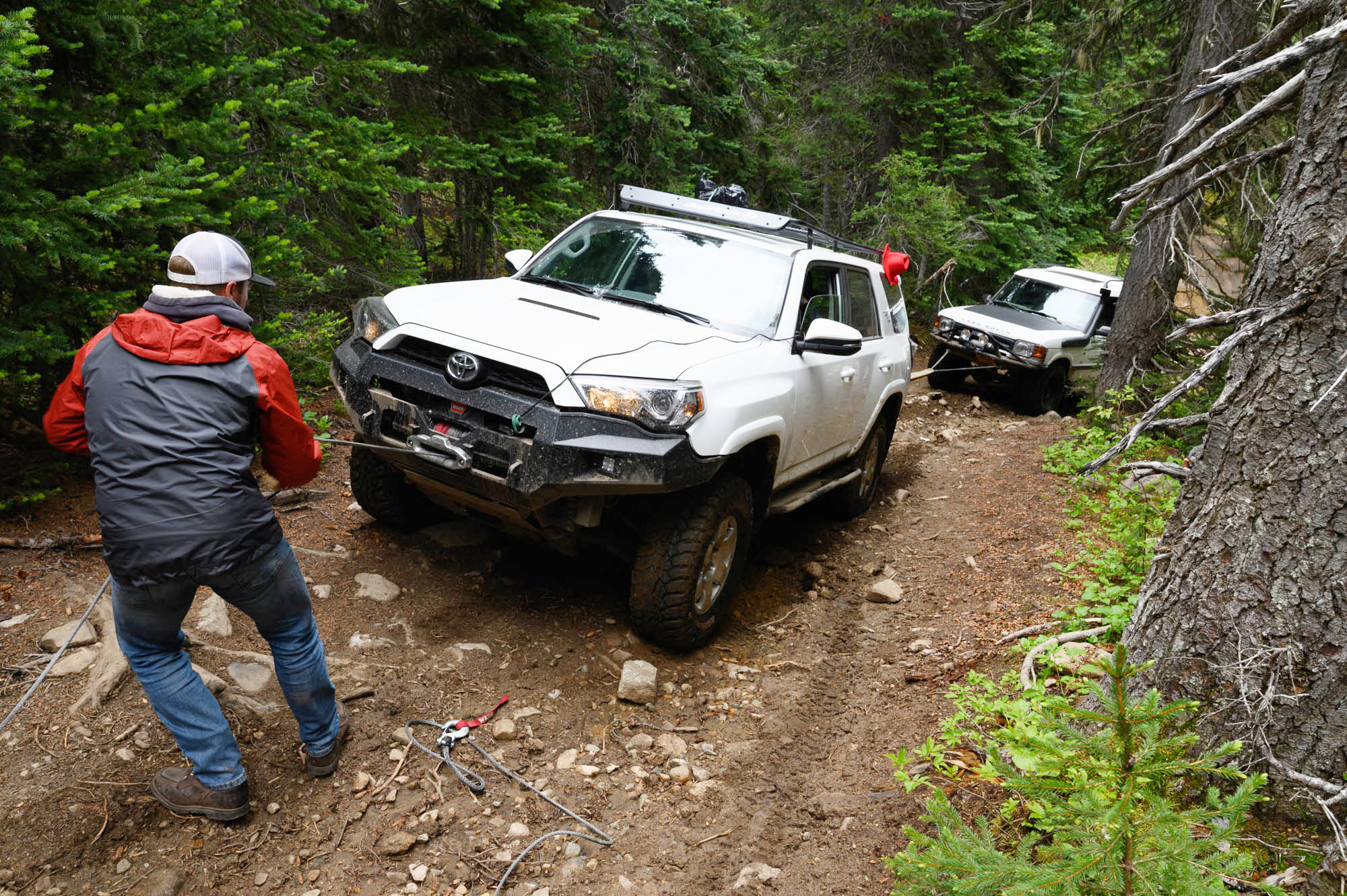
Paul recalled that they used an ARB 3.5-inch snatch strap between his truck and Jim’s, but it was long—about 20 feet. They had to shorten it to go around the tight corner. Paul said it wasn’t a difficult hill, about 15 to 18 degrees with loose rock, but his truck stopped moving. “My 4Runner could not move ahead. Jim’s truck was dead weight and heavy.” It rapidly became apparent they needed more pulling power than just Paul’s 4Runner. The team then ran Paul’s winch line up the hill, attaching it to a tree with a tree strap. “We pulled and pulled, and my truck barely moved. This was our first, ‘Oh God, this isn’t going to be as easy as we think.’ It was going to take more than one truck and a lot of coordination. It would probably take another winch and two more trucks.”
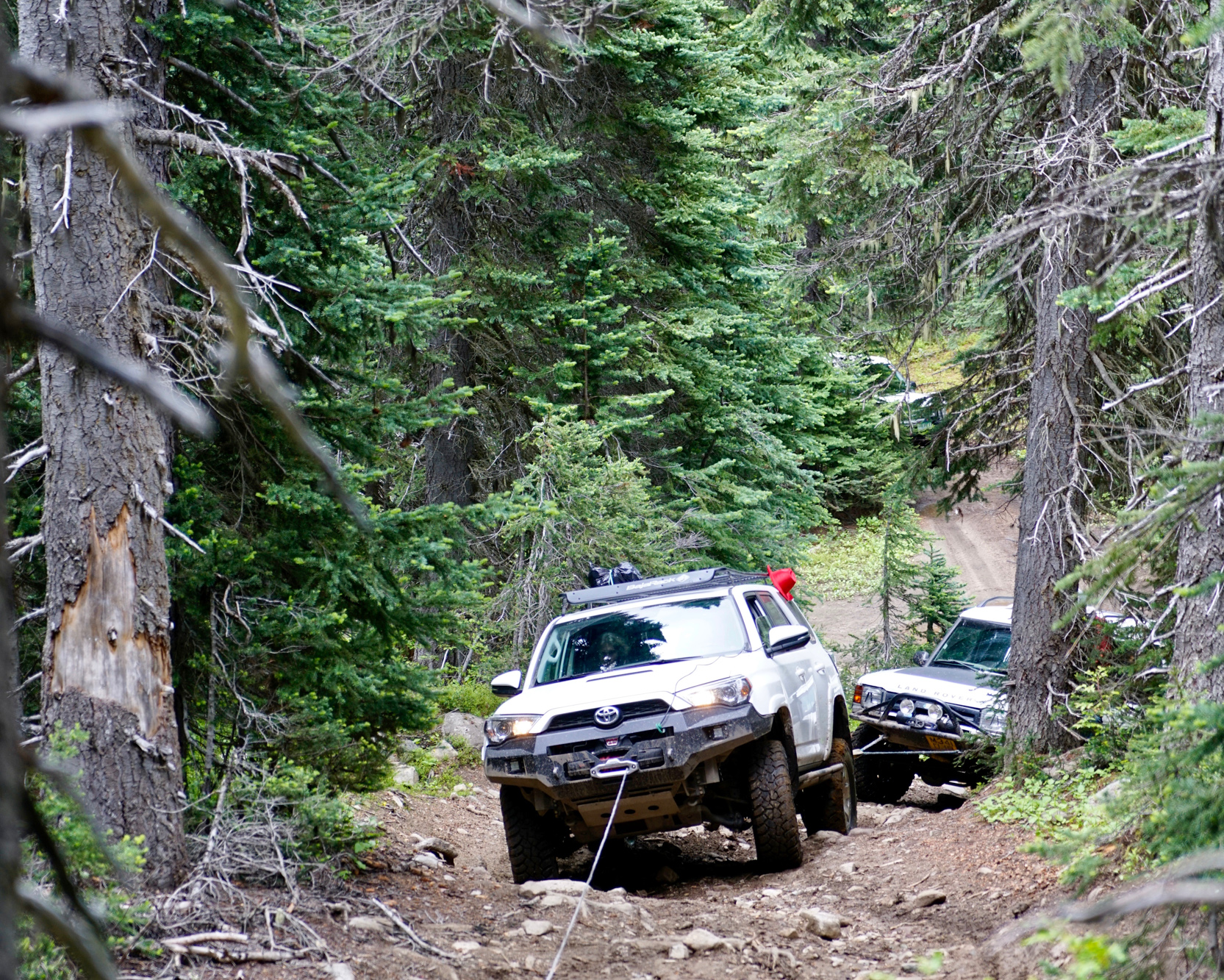
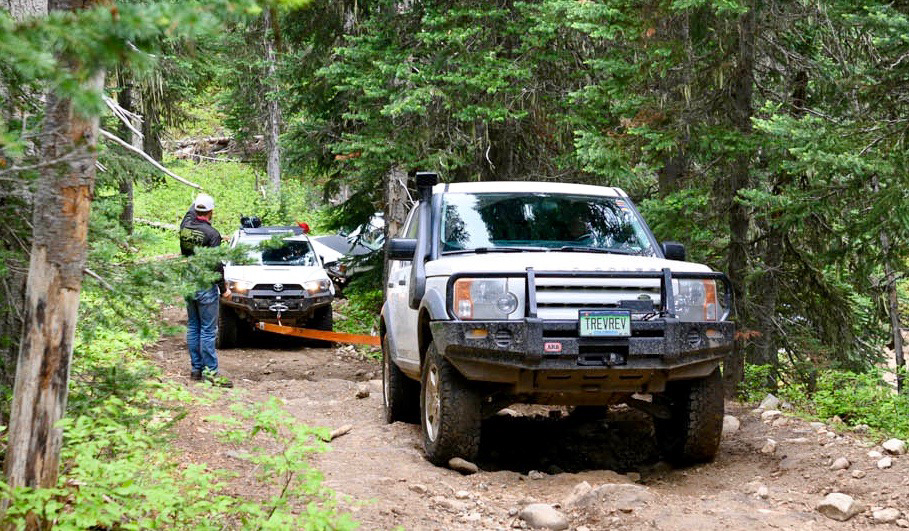
The solution was to hook Paul’s truck to Kim Casares’s LR3, so there were two trucks towing Jim’s Discovery. Even this was not sufficient to conquer the obstacle. We then added the winch from Chris’ Defender. Because of a 90-degree turn in the trail, Chris positioned his truck farther up the hill. He passed his winch line through a recovery ring attached to a tree strap at the turn in the trail and attached it to Kim’s LR3. Using this redirect pull, Chris was able to help the towing train ascend the hill.
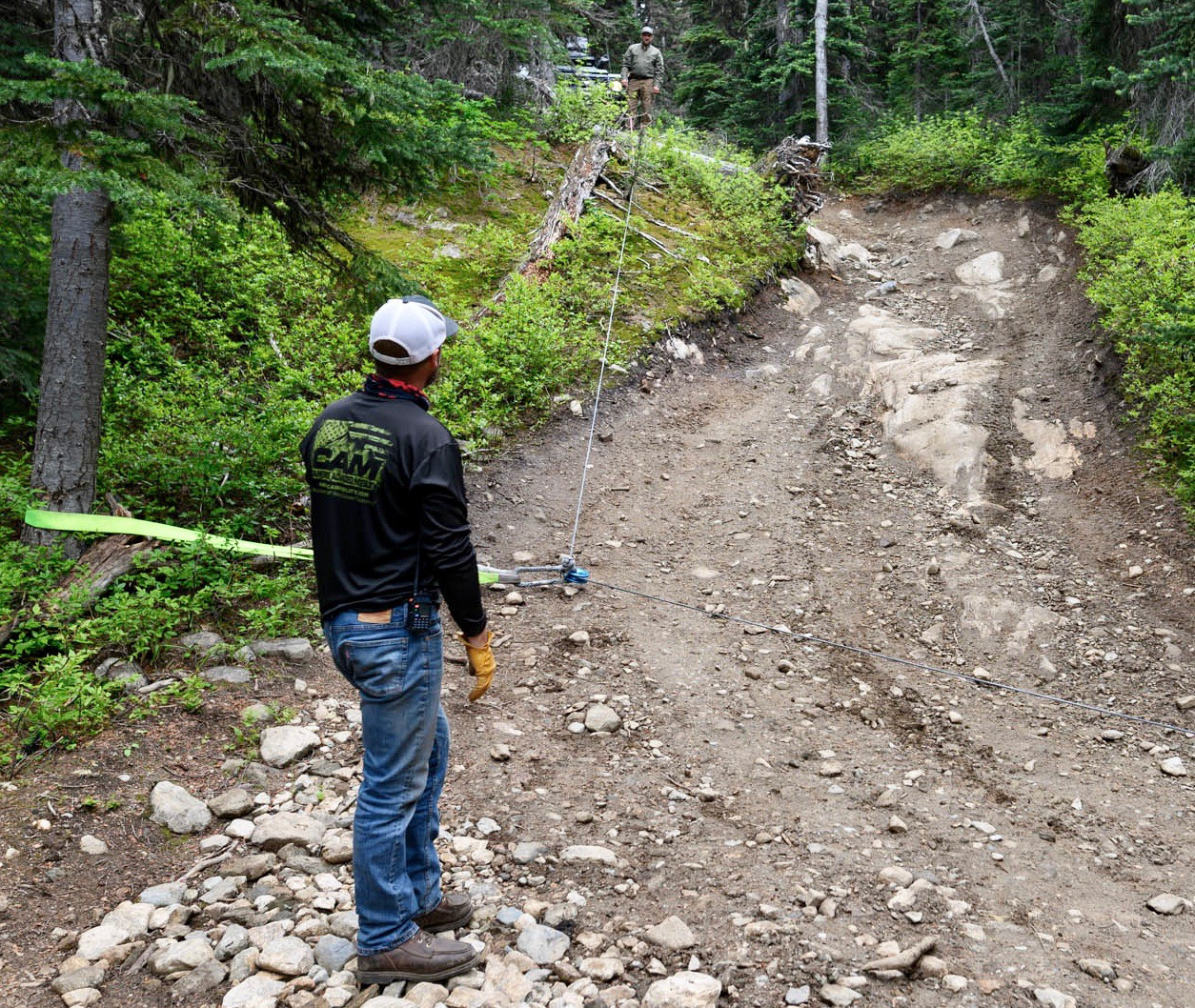

When asked about how the team decided who was in charge of the recovery, Chris said, “It was tough, because of the nature of the group, since we are all off-road educators.” Chris explained that it ultimately came down to each driver and the group as a whole: each was responsible for the safety of their truck. The recovery team had to be sure they did not damage any of the trucks while helping Jim’s out. If something was not working for Jim, he could say stop, as could the other drivers. Chris, Jim, and Tim took turns spotting and guiding the towing train through the obstacles.
Another tricky challenge was a steep hill with a v-shaped gulley (v-gulley) up the middle. It’s a tricky section to drive if your truck is doing well, let alone being towed. Chris pointed out, “So this is where experience comes in. We think, here’s the challenge—what can we do to not beat up the trucks? We could have hit the gas and tried to muscle our way up, but would that be the right thing to do? The smart thing is to think carefully about how to get the towing train up the hill without doing damage to the trucks. Imagine if we had yet another truck disabled?”
There were two spots in the v-gulley where things were taking too long. Chris’ winch was added to the effort, initially with a redirect pull. Tim Hüber explained, “We had a redirect pull using the recovery ring, and I noticed that Chris’ Defender started sliding up the hill. As soon as I saw that, I thought, why don’t we just bring Chris’ truck up to the tree, tie the back of the Rover to the tree with a tree strap so he can’t go anywhere, then use his winch. In this situation, even though the LR3 was in the front position, it had Chris’ winch line on it. I was in Jim’s truck at the back, and the winch line would pull taut and pull us in a straight line. The LR3 and the 4Runner were in the middle. So, looking back at the v-gulley scenario, I realized there was a lot of tension on the front of Kelsey’s truck and on the back, and we’re all trying to pull her into the gulley. That was definitely a concern.”
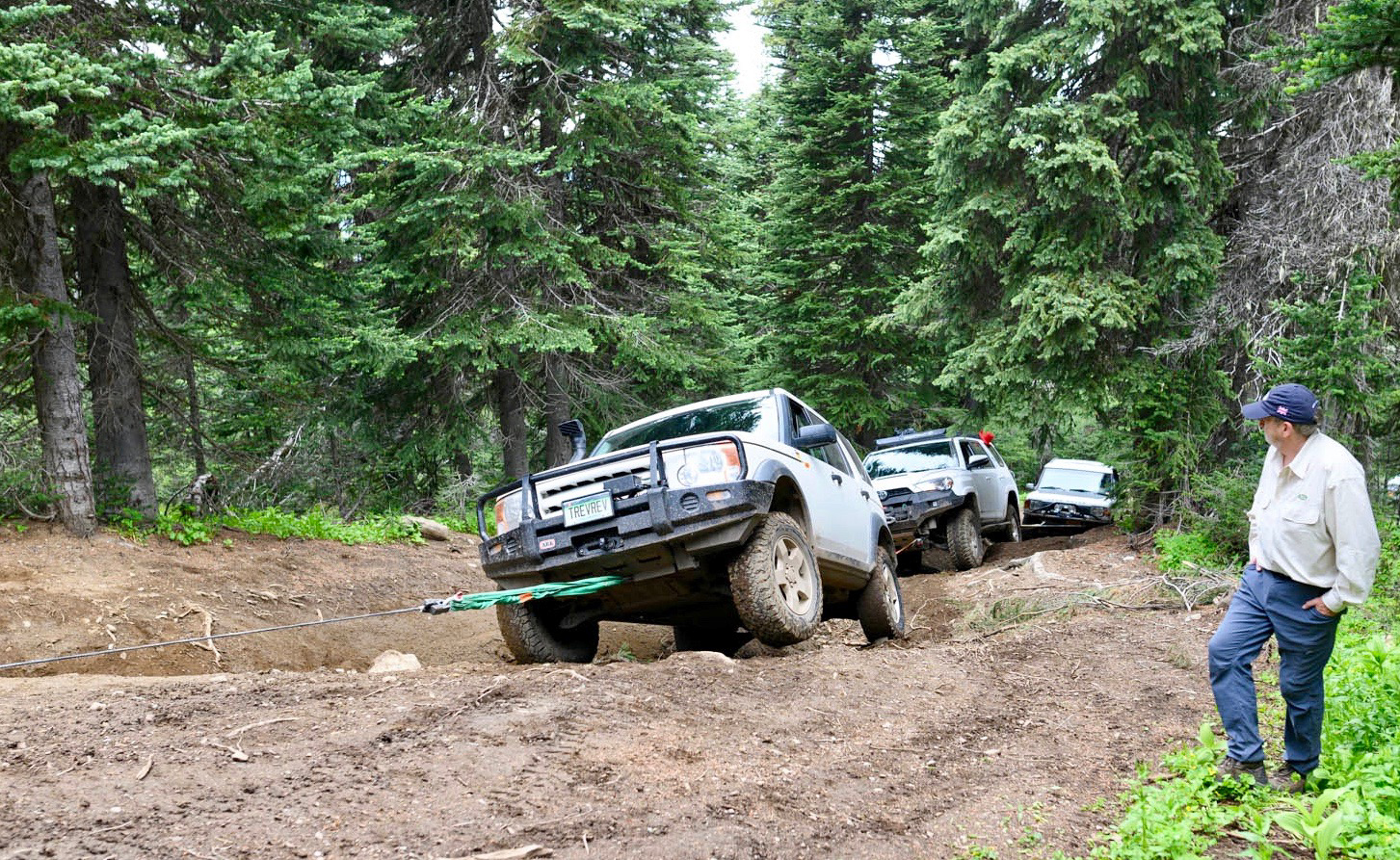
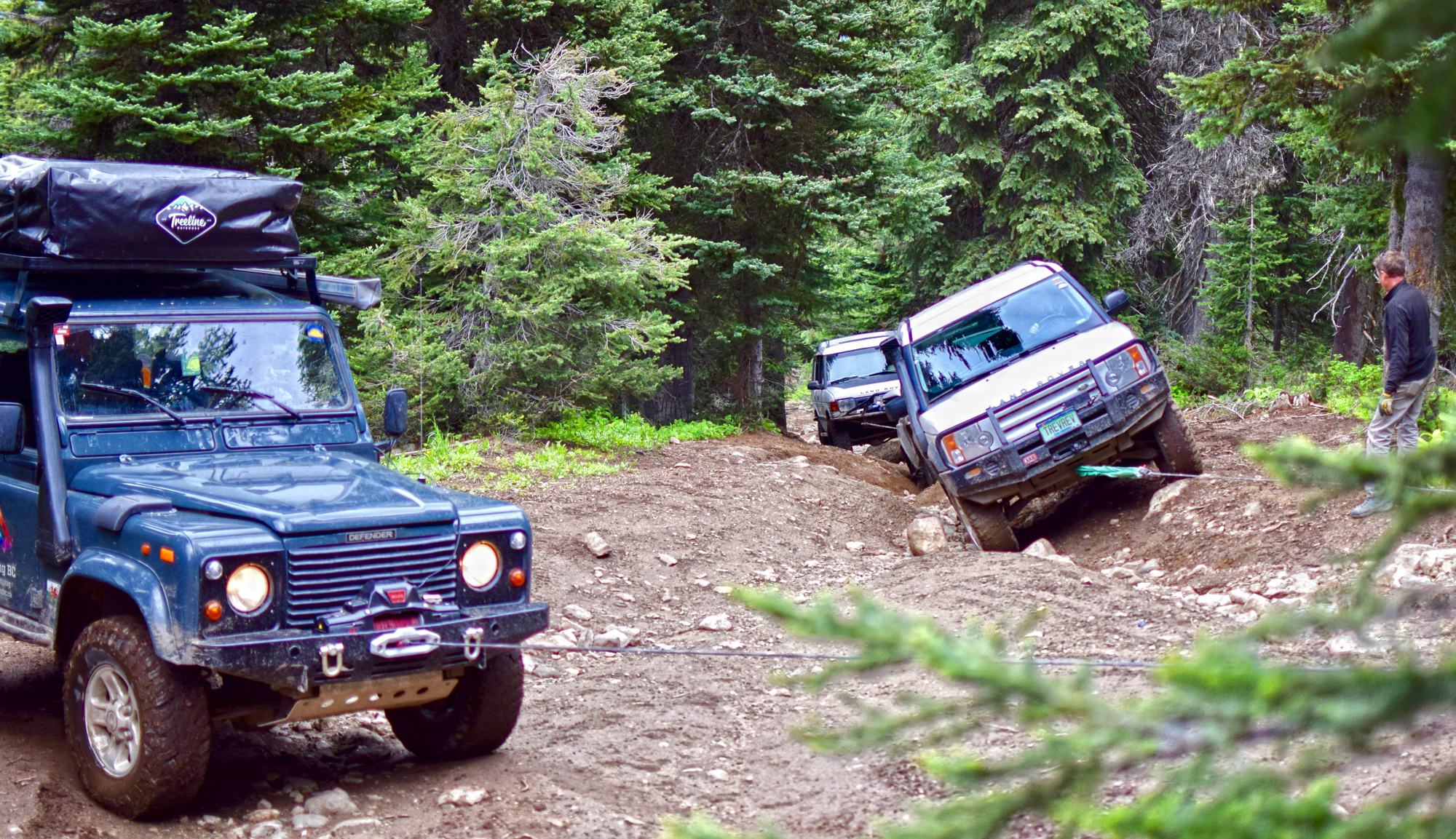
Paul recounted, “There were times my truck moved laterally three or four feet in half a second, but we were all aware it would do that. I wasn’t overly worried about it.”
After the v-gulley, the drivers fell into a rhythm of getting the trucks up and down more hills: rigging, pulling, stopping, and re-rigging the straps. We lost count of all the obstacles—there were so many.
On one of the other obstacles, Chris’ Defender was added to the pull, so there were three trucks pulling Jim’s truck. Chris recalled, “I drive a standard, my truck is light, and I was pulling two trucks with automatic transmissions. I had to be smart, so I didn’t burn out my clutch. It was more about feeling the pull on my truck and how it was rotating, and being gentle with the clutch, so I didn’t stall the engine and cause more problems.”
Tim summed up the recovery thought process: “On the more mild hills and steps, I knew one tow truck would work, but when we got to the tough hills, I realized we’d have to go with 8-wheel drive. We could use one truck, for example, and use MaxTrax with Paul’s 4Runner, but then you realize there’s a lot of stress on that tow truck. Then you think, do we get the winch out? That’s fine, and it’ll work on one hill, but it’s so slow that if there are 15 or 30 hills, I’m seeing us at midnight with headlamps on, winching slowly up the hills. The quicker option would be 8-wheel drive, and if that doesn’t work, go to 12-wheel drive (three trucks towing). On some of the obstacles, you don’t want to go up too quickly because they are super rocky. Let’s use the winch again. All these things will work, but you have to decide on the best option for the terrain. By choosing the slowest options, you could have a really brutal day and night. If you pick more efficient techniques and gear, you can knock hours off your day. By the time we reached camp that evening, we said, ‘Hey it was a tough day, but we’re here now sitting around the campfire, able to enjoy the sunset, versus out there, still slogging away.’”
“Pretty crazy, really,” said Paul. “I would never want to do it again. It’s certainly the biggest recovery I’ve been involved in, and hopefully the only one. Our recovery was a long, seven and a half straight hours of problem-solving in difficult conditions, trying not to get too tired and make mistakes and break things on the trucks. We could’ve broken axles, blown CV joints, broken differentials, all of those things could’ve happened. It wouldn’t have been like we were doing something stupid to make them happen. Then we would’ve been doing everything times two, which would have led to at least a 15-hour recovery.”
Paul added, “I don’t think you can underestimate how well we coordinated the driving with me in the middle and Kelsey at the front in Kim’s LR3, and Tim or Jim at the back in Jim’s truck. They took turns braking and steering Jim’s truck behind me. Anyone less experienced at driving, and it could have been a whole other story. The way Kelsey led, the way I gave her slack, as difficult as it was, I don’t think it could’ve gone any better.”


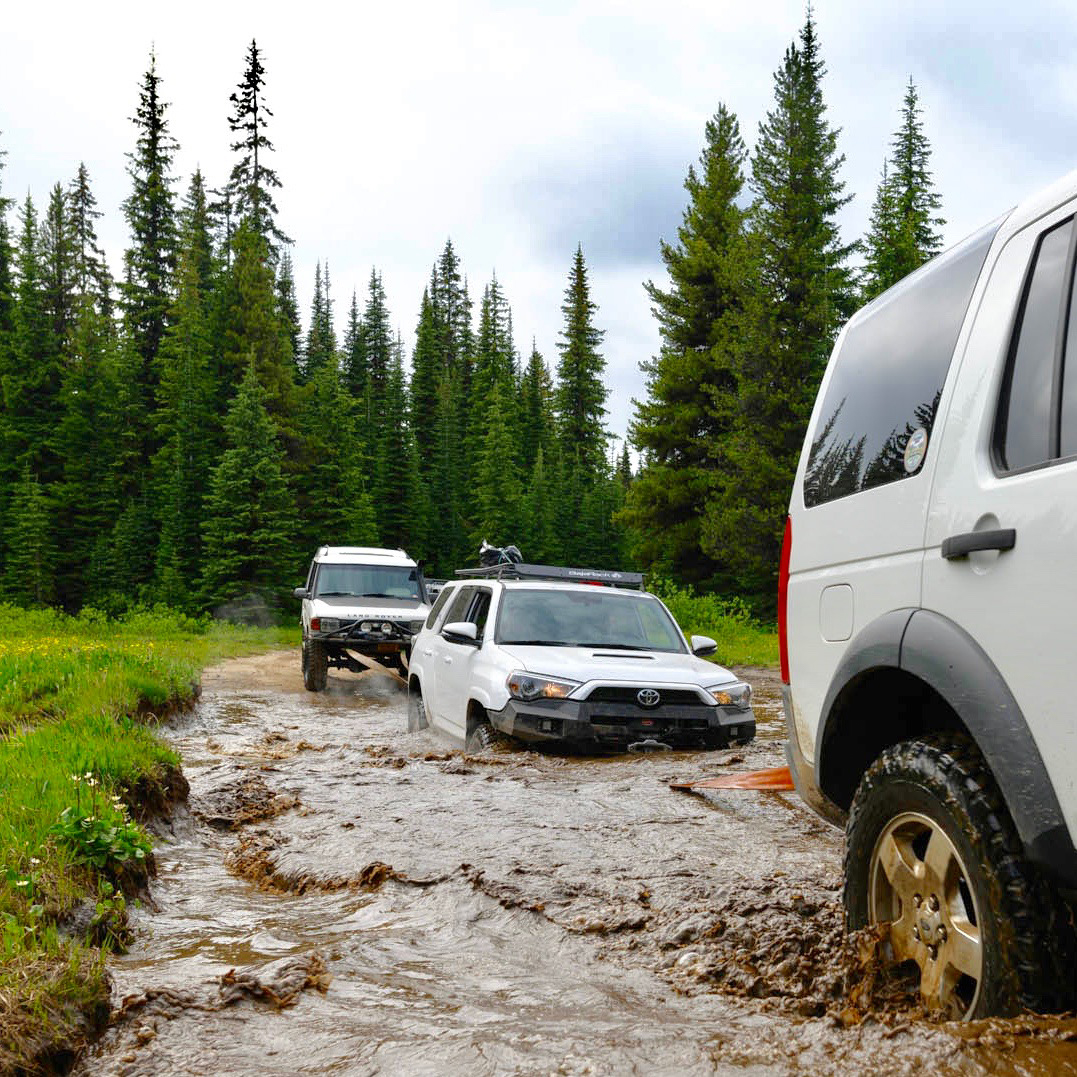
Keeping Jim’s powerless truck under control was no easy task, either. Drivers of Jim’s truck leaned as hard as they could on the brakes and judiciously used a supplemental hand brake when needed. “Tim and I had to use the hand brake; we did what we had to do. It’s a drum brake on the driveline. You have to be very sensitive with it; it’s designed to lock up immediately, not come to a slow, smooth stop. So using it as we did puts a lot of load and undue stress on the driveline,” said Jim. On some downhills, Jim disconnected his truck from the towing train and coasted.
The ARB snatch strap between the lead truck and Paul’s truck had a 20-percent stretch that added enough spring to keep the trucks from being jerked around as much, but did not have enough kinetic energy buildup to make things dangerous. Keeping the strap as long as possible, within reason, allowed the driver behind to see the terrain ahead and react if the truck in front had to stop suddenly. However, a long strap can be difficult on tight corners. By the time the lead truck has gone around a corner, the strap is taut and wants to pull the following truck sideways. On tight corners, we shortened the straps. For big obstacles, we could also lengthen the straps enough to let the lead truck finish climbing the obstacle before the following truck came up. This reduced the amount of force needed to get the trucks up the hill. Nevertheless, with all the rigging and re-rigging, the tow straps and soft shackles took quite a beating.

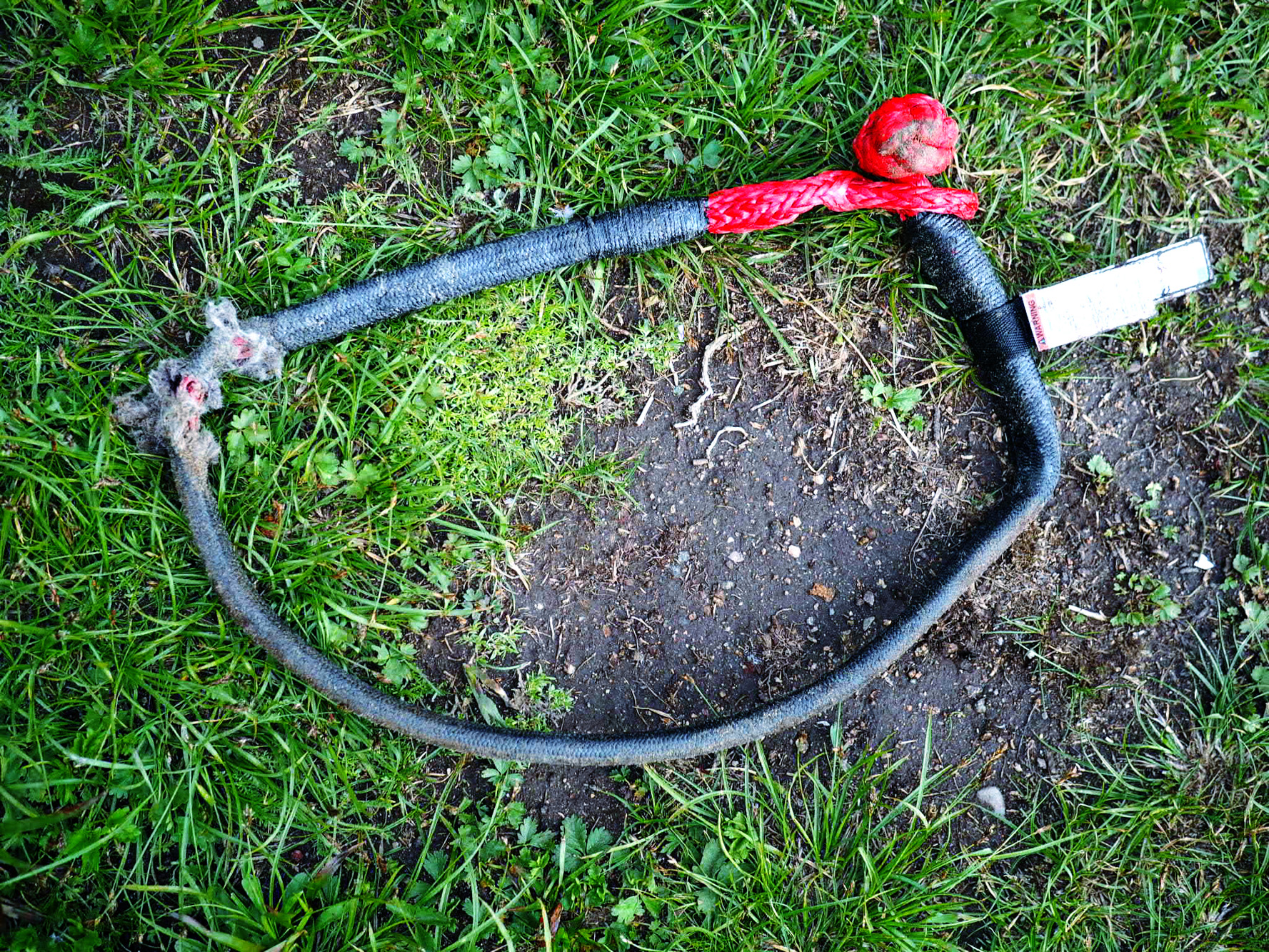
Emotions
Jim West recalled his emotions at the v-gulley: “All the 7P, Overlanding BC, you can toss any of us together, and there is little to no drama. But at one point, I got stressed, feeling bad for the group because my truck was not running and we had to recover it. Chris had it well under control, so I decided to let him manage the recovery for that phase. There was good-natured banter on the radio about me going for a run along the trail to release stress. If I’m not well exercised, I get like my border collie, a little snippy. I was fine after that. If it hadn’t been my truck, if it had been someone else’s truck, I would’ve enjoyed the whole thing.”
Chris added, “We were getting faster and faster, and Jim and I had a tactical disagreement over the recovery at that point, so we each took a breath, Jim went for a run, and we slowed down the recovery. Emotions can get in the way of a safe and efficient recovery, and we all knew that.”
Overall though, the team was calm and focused, and while we all had some anxiety, it was just the right amount to keep everybody alert. My husband, Steve, was probably the least anxious, stating, “Apart from a little anxiety when I watched the towing train come up the v-gulley, I didn’t really feel any anxiety about the rest of the recovery effort. These guys are some of the best off-highway drivers and recovery experts in North America. I had no doubts about their ability to get everybody off the trail safely. If I had any anxiety at all, it was that I didn’t want our truck to get stuck or break down!”
What do the experts recommend to be prepared for vehicle recovery on challenging trails?
I asked members of the team what they generally recommend to be well prepared for vehicle recovery situations.
Jim West summed it up: “First, a well-vetted truck (ha). At least one truck should have a winch and winch kit, good-quality kinetic strap or rope, and a few soft or bow shackles. And the skills to know how to fully utilize your equipment.”
Paul Cooper offered a philosophical perspective: “Have the best quality stuff, rated for your trucks. These are consumables, and you are towing an expensive truck. Keep the costs in perspective. Look at what we did in the recovery: three trucks. Add the cost of all those, say the trucks cost $80,000 altogether. I don’t mind the cost of the recovery strap replacement. I wouldn’t mind if it cost $1,000 to buy new recovery gear, as long as the trucks come out without damage. It’s such a tiny percentage of the cost of what they are preserving.”
“Understand how your truck is equipped, understand what gear you can use on your truck, and how to use it effectively and safely. Don’t buy stuff that everyone else has that you can’t use on your truck. Take a class from accredited instructors at overland rallies.”
Tim Hüber talked about gear for Whipsaw: “Have good tires, not necessarily mud-terrains. In the slick mud of Whipsaw, the mud-terrains packed the mud into the tread just like the all-terrains. We couldn’t get up speed to clear the treads. If you have all-terrains, I wouldn’t shy away from Whipsaw.
Buy one kinetic strap, that in a pinch, you could use as a towing strap. Just don’t load it with tons of kinetic energy. Get a flat towing strap, two bow shackles, two soft shackles, and you can figure out how to get out.
A winch for this trail would be good with a winch line extension. You have trees to attach a tree strap. There may not always be one where you need it, but chances are there will be one or more. Plastic recovery boards like MaxTrax are going to slip on the slick rock. They are another tool in your box, but on Whipsaw, I don’t see them as being the go-to.
Three trucks are a good minimum number, but I’d still be comfortable doing it with two trucks or solo, bearing in mind that you may need help to get off the trail if you had a catastrophic mechanical failure. Three trucks is a safe number. You have enough trucks to get through it.”
Chris Walker says, be smart, be safe: “Have a sound mechanical truck, decent tires. Don’t forget good mental prep—be prepared, be thoughtful.
Recovery gear: It depends on what you have as a truck and the kinds of places you are going. You don’t necessarily have to have a winch, but it’s a good piece of kit when things are not going well. But I’d rather drivers be smart in the first place, make good decisions, and try not to get stuck. Be smart, be safe. Pick good lines, take your time, be as slow as possible, as fast as is necessary, technique before technology, and make choices that are mechanically sympathetic.
In general, whether solo or with a group, take a first aid kit, a satellite communications device for emergencies, a winch, a strap to attach your truck to things, two bow shackles, two soft shackles, a recovery ring, a receiver hitch, and that’s it. Stuff happens; it is what it is. It was a mechanical issue with Jim’s truck, not poor driving choices along the trail.”
Final Night
On our final night at camp, when the challenge was behind us, and the remaining trail out was easy, we camped at the well known Dick’s Cabin site, a memorial to Princeton ranch hand Richard Holding and to two other locals, Robert Beale, a rancher, and his wife, Evelyn Beale.
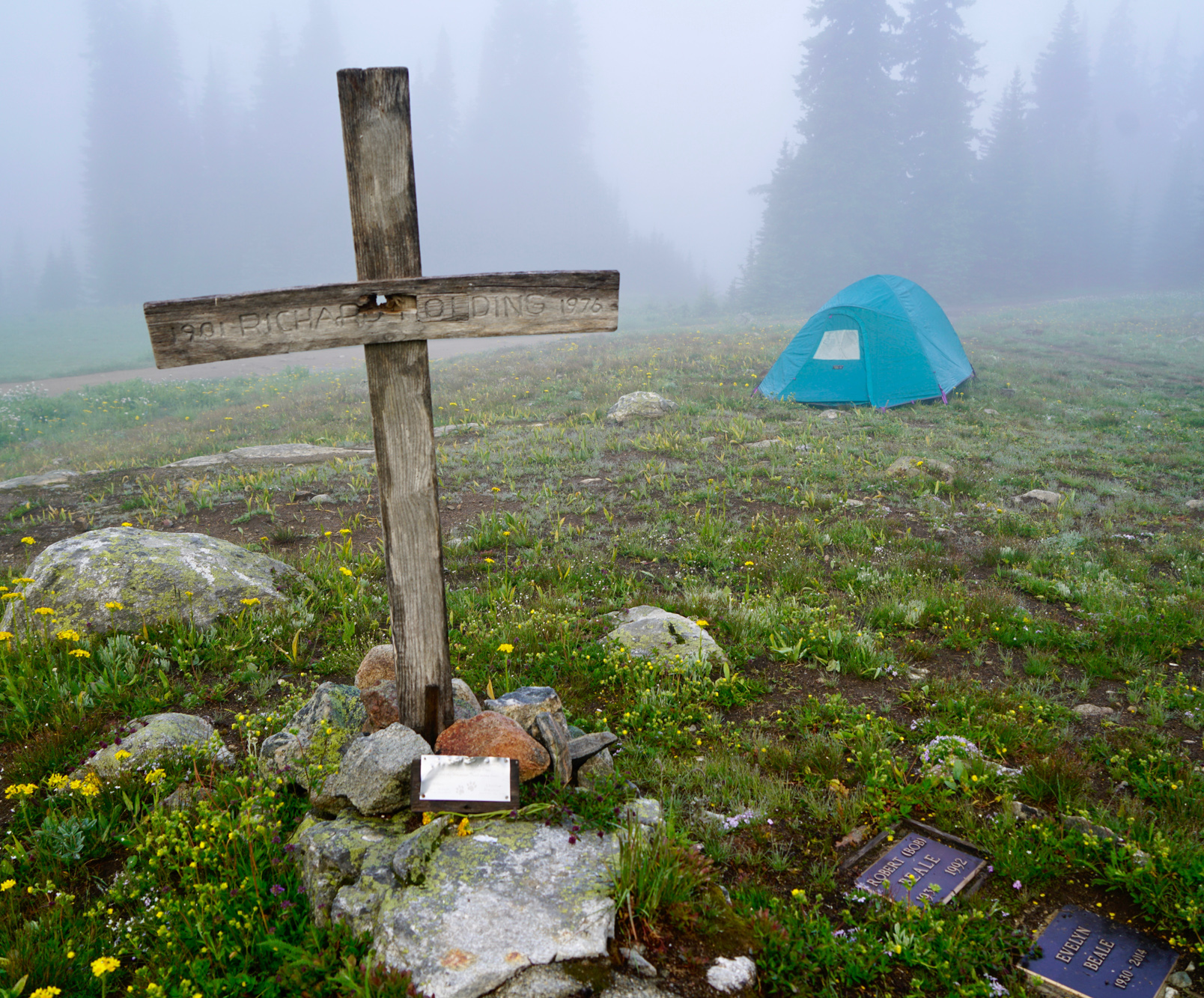
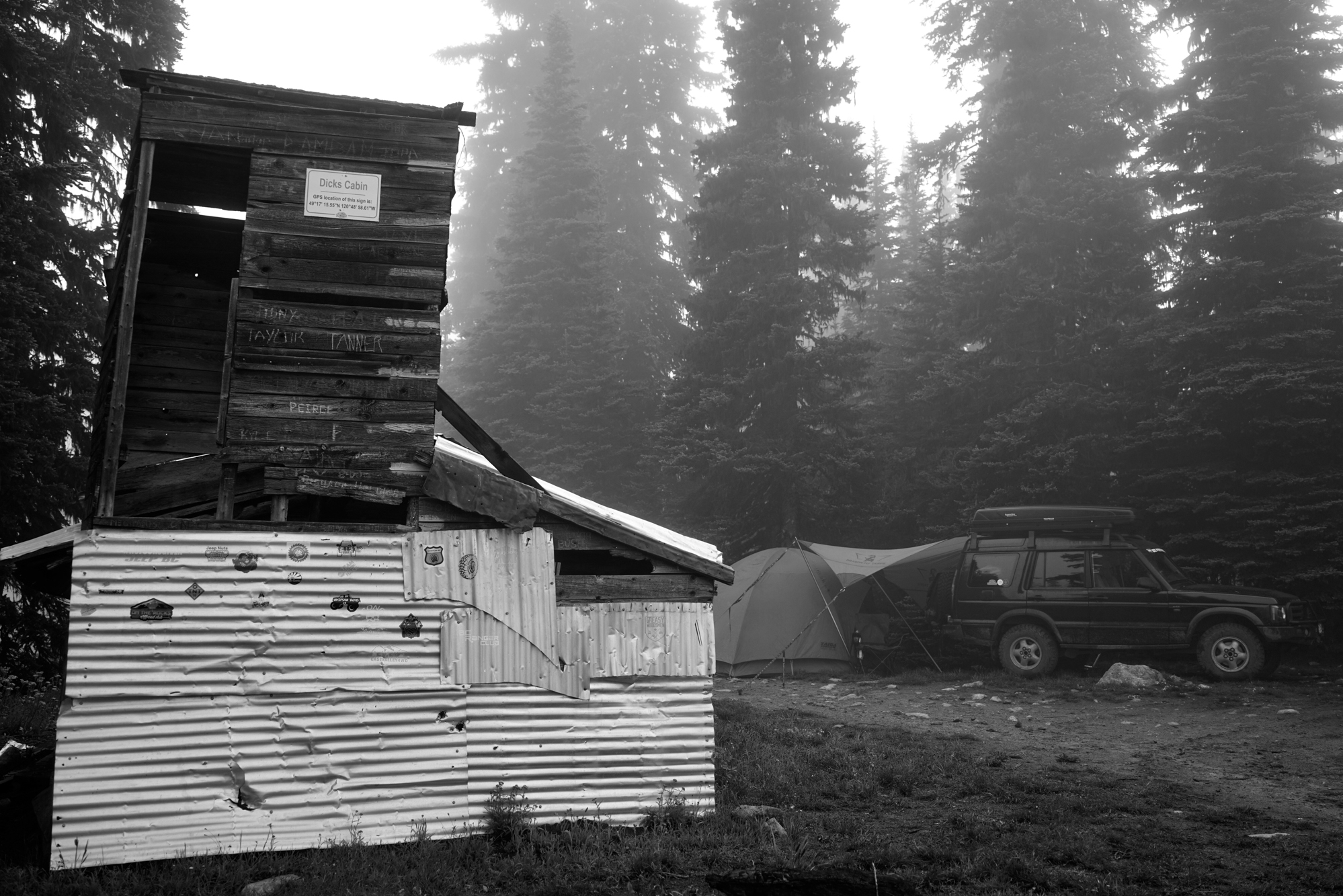
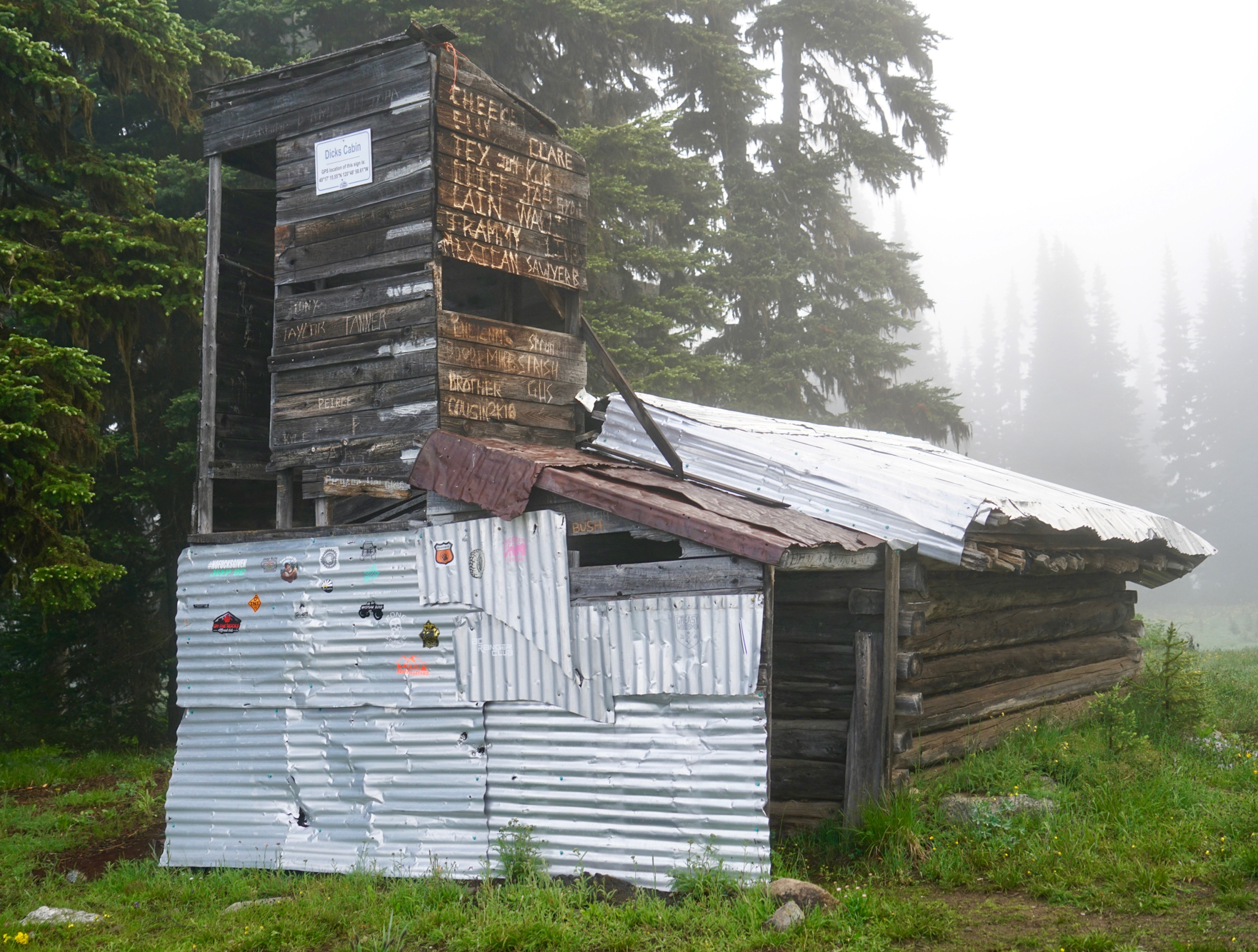
A glorious orange sunset painted the sky as we roasted hotdogs on the fire, a simple meal in celebration of our successful recovery. A little later, an intense thunderstorm rolled in, and a lightning strike landed a few hundred meters from Jim West.
“That first lightning strike was really close to me. It made me flinch. But I’m still here, so all good. And when the fog rolled in, it was lovely. If you get rid of all the bugs, I’m in for another Whipsaw!” quipped Jim.
Kim Casares of the 7P team summed up the beauty of the moment: “In the alpine meadow that final night, it reminded me that there are so many beautiful places in the world and Whipsaw is another. Until Whipsaw, I always traveled by myself. I was trying to process what it is like to travel in a group. I needed to learn to experience travel with others. It was a positive experience for me. I realized I’ve been missing out on good stuff. The bonding was nice. I enjoyed sharing the experience around the campfire.”
Our three-day trip did not span international boundaries, but it was a classic overland adventure, exploring the remote, Whipsaw Trail and the surrounding area. We pitched our tents next to colorful alpine meadows open to big sky, places where your heart sings, and life slows.
Our self-reliance was tested by an unexpected challenge, and our friendships were enhanced as we worked together to finish the journey we started. We saw and did things that will be woven into stories we tell again and again. Trail lore, overlanding lore, a touch of Camel Trophy.
